1998 TOYOTA T100 towing
[x] Cancel search: towingPage 25 of 214
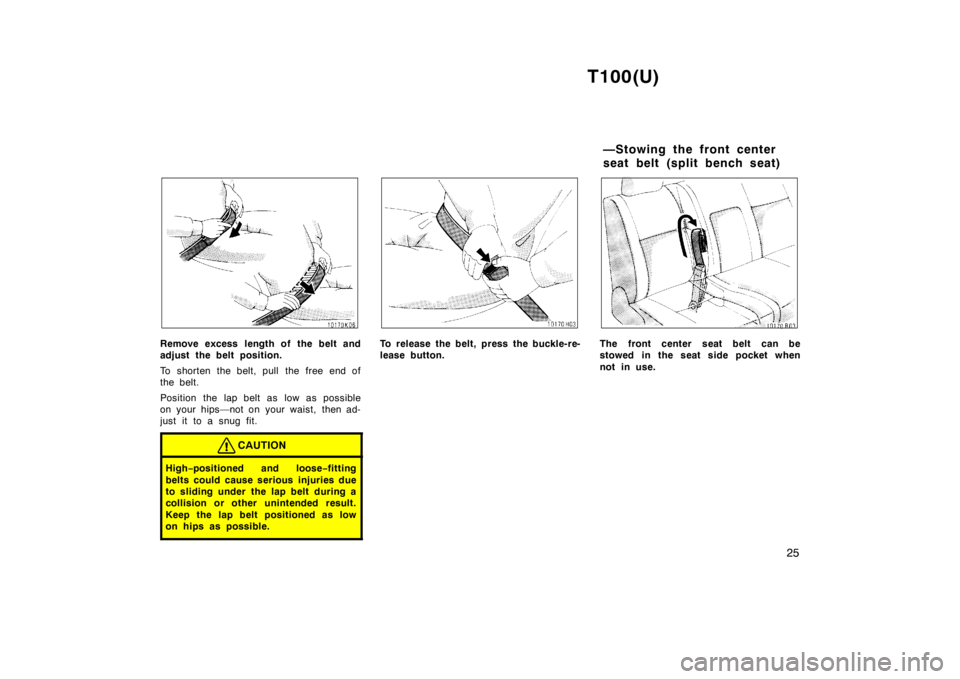
T100(U)25
Remove excess length of the belt and
adjust the belt position.
To shorten the belt, pull the free end of
the belt.
Position the lap belt as low as possible
on your hips—not on your waist, then ad-
just it to a snug fit.
CAUTION
High−positioned and loose −fitting
belts could cause serious injuries due
to sliding under the lap belt during a
collision or other unintended result.
Keep the lap belt positioned as low
on hips as possible.
To release the belt, press the buckle-re-
lease button.The front center seat belt can be
stowed in the seat side pocket when
not in use. —Stowing the front center
seat belt (split bench seat)
Page 26 of 214
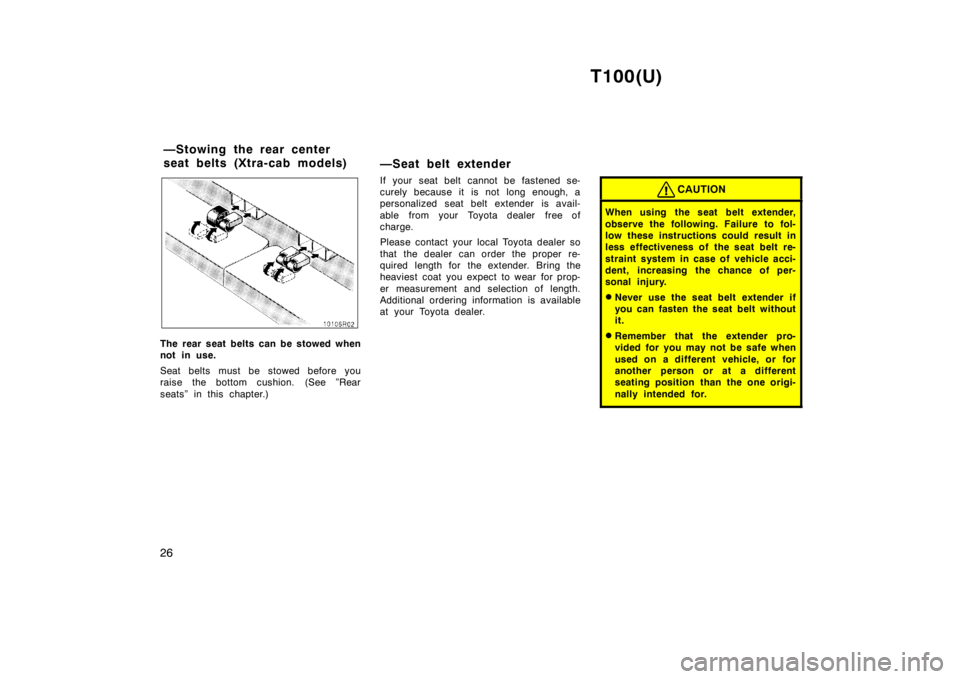
T100(U)
26
The rear seat belts can be stowed when
not in use.
Seat belts must be stowed before you
raise the bottom cushion. (See ”Rear
seats” in this chapter.) —Seat belt extender
If your seat belt cannot be fastened se-
curely because it is not long enough, a
personalized seat belt extender is avail-
able from your Toyota dealer free of
charge.
Please contact your local Toyota dealer so
that the dealer can order the proper re-
quired length for the extender. Bring the
heaviest coat you expect to wear for prop-
er measurement and selection of length.
Additional ordering information is available
at your Toyota dealer.
CAUTION
When using the seat belt extender,
observe the following. Failure to fol-
low these instructions could result in
less effectiveness of the seat belt re-
straint system in case of vehicle acci-
dent, increasing the chance of per-
sonal injury. �
Never use the seat belt extender if
you can fasten the seat belt withoutit.
� Remember that the extender pro-
vided for you may not be safe when
used on a different vehicle, or for
another person or at a different
seating position than the one origi-
nally intended for.
—Stowing the rear center
seat belts (Xtra-cab models)
Page 58 of 214

T100(U)
58
The gauge works when the ignition
switch is on and indicates the approxi-
mate quantity of fuel remaining in the
tank.
It is a good idea to keep the tank over
1/4 full.
This fuel gauge has a non-return type
needle which remains at the last indicated
position when the ignition switch is turned
off.
If the fuel level approaches ”E” or the low
fuel level warning light comes on, fill the
fuel tank as soon as possible.
If the fuel tank is completely empty, the
malfunction indicator lamp comes on. Fill
the fuel tank immediately. The indicator lamp goes off after driving
several times. If the indicator lamp does
not go off, contact your Toyota dealer as
soon as possible.
On inclines or curves, due to the move-
ment of fuel in the tank, the fuel gauge
needle may fluctuate or the low fuel level
warning light may come on earlier than
usual.The gauge indicates the engine coolant
temperature when the ignition switch is
on. The engine operating temperature
will vary with changes in weather and
engine load.
If the needle points to the red zone or
higher, stop your vehicle and allow the
engine to cool.
Your vehicle may overheat during severe
operating conditions, such as:
� Driving up a long hill on a hot day.
� Reducing speed or stopping after high
speed driving.
� Idling for a long period with the air
conditioning on in stop-and-go traffic.
� Towing a trailer.
Fuel gauge
(with tachometer)
Engine coolant
temperature gauge
Page 67 of 214

T100(U)67
Your automatic transmission has a shift
lock system to minimize the possibility of
incorrect operation. This means you can
only shift out of ”P” position when the
brake pedal is depressed (with the ignition
switch in ”ON” position and selector lever
pulled toward you).
(a) Normal driving
1. Start the engine as instructed in ”How to start the engine” in Part 3. The
transmission must be in ”P” or ”N”.
2. With your foot holding down the brake pedal, shift the selector lever to ”D”.
In ”D” position, the automatic transmission
system will select the most suitable gear
for running conditions such as normal
cruising, hill climbing, hard towing, etc.
Always turn the overdrive switch on for
better fuel economy and quieter driving.
Two-wheel drive models–If the engine
coolant temperature is low, the transmis-
sion will not shift into the overdrive gear
even with the overdrive switch on. Four-wheel drive models–If the engine
coolant temperature is low and the vehicle
is travelling at low speed or when the
four-wheel drive control lever is in ”L4”
(four-wheel drive, low range), the trans-
mission will not shift into the overdrive
gear even with the overdrive switch on.
(See ”Four-wheel drive system” in this
Chapter for information of the four-wheel
drive control lever.)
CAUTION
Never put your foot on the accelera-
tor pedal while shifting.
3. Release the parking brake and brake
pedal. Depress the accelerator pedal
slowly for smooth starting.
(b) Using engine braking
To use engine braking, you can downshift
the transmission as follows: � Turn off the overdrive switch. The ”O/D
OFF” indicator light will come on and
the transmission will downshift to the
third gear. �
Shift into the ”2” position. The trans-
mission will downshift to the second
gear when the vehicle speed drops
down to or lower than the following
speed, and more powerful engine brak-
ing will be obtained.
Tw o −wheel drive models—
3RZ −FE engine.....112 km/h (70 mph)
5VZ −FE engine.....117 km/h (73 mph)
Four −wheel drive models—
—Four −wheel drive control lever
in ”H2” and ”H4”.....112 km/h (70 mph)
—Four −wheel drive control lever
in ”L4”.....38 km/h (24 mph)
� Shift into the ”L” position. The trans-
mission will downshift to the first gear
When the vehicle speed drops down to
or lower than the following speed, and
maximum engine braking will be ap-
plied.
Tw o −wheel drive models—
3RZ −FE engine.....54 km/h (34 mph)
5VZ −FE engine.....56 km/h (35 mph)
Four −wheel drive models—
—Four −wheel drive control lever
in ”H2” and ”H4”.....54 km/h (34 mph)
—Four −wheel drive control lever
in ”L4”.....10 km/h (6 mph)
Page 68 of 214

T100(U)
68
Vehicles with cruise control–When the
cruise control is being used, even if you
downshift the transmission by turning off
the overdrive switch, engine braking will
not be applied because the cruise control
is not cancelled. For ways to decrease
the vehicle speed, see ”Cruise control” in
this chapter.
CAUTION
Be careful when downshifting on a
slippery surface. Abrupt shifting
could cause the vehicle to spin or
skid.
(c) Using ”2” and ”L” positions
The ”2” and ”L” positions are used for
strong engine braking as described pre-
viously.
With the selector lever in ”2” or ”L”, you
can start the vehicle in motion as with the
lever in ”D”.
With the selector lever in ”2”, the vehicle
will start in the first gear and automatical-
ly shift to the second gear.
With the selector lever in ”L”, the trans-
mission is engaged in the first gear.
NOTICE
�
Be careful not to overrev the en-
gine. Watch the tachometer to keep
engine rpm from going into the red
zone. The approxmate maximum al-
lowable speed for each position is
given below for your reference:
Two-wheel drive models—
”2” 100 km/h (62 mph)
”L” 55 km/h (34 mph)
Four-wheel drive models—
—Four-wheel drive control lever
in ”H2” and ”H4” ”2” 100 km/h (62 mph)
”L” 55 km/h (34 mph)
—Four-wheel drive control lever
in ”L4” ”2” 35 km/h (21 mph)
”L” 20 km/h (12 mph)
� Do not continue hill climbing for a
long time in the ”2” or ”L” posi-
tion. This may cause severe auto-
matic transmission damage from
overheating. To prevent such dam-
age, use ”D” position for hill climb-
ing or hard towing.
(d) Backing up
1. Bring the vehicle to a complete stop.
2. With the brake pedal held down with your foot, shift the selector lever to the
”R” position.
NOTICE
Never shift into reverse while the ve-
hicle is moving.
(e) Parking
1. Bring the vehicle to a complete stop.� Pull the parking brake lever up fully to
securely apply the parking brake.
� With the brake pedal pressed down,
shift the selector lever to the ”P” posi-
tion.
CAUTION
While the vehicle is moving, never
attempt to move the selector lever
into ”P” position under any circum-
stances. Serious mechanical damage
and loss of vehicle control may re-
sult.
Page 69 of 214
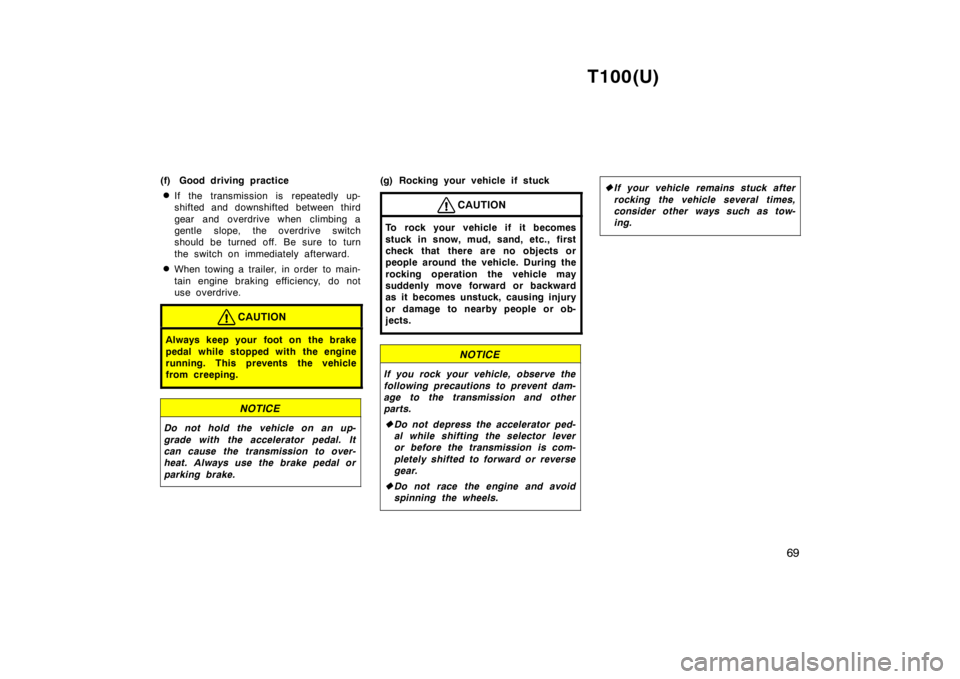
T100(U)69
(f) Good driving practice
� If the transmission is repeatedly up-
shifted and downshifted between third
gear and overdrive when climbing a
gentle slope, the overdrive switch
should be turned off. Be sure to turn
the switch on immediately afterward.
� When towing a trailer, in order to main-
tain engine braking efficiency, do not
use overdrive.
CAUTION
Always keep your foot on the brake
pedal while stopped with the engine
running. This prevents the vehicle
from creeping.
NOTICE
Do not hold the vehicle on an up-
grade with the accelerator pedal. It
can cause the transmission to over-
heat. Always use the brake pedal or
parking brake.
(g) Rocking your vehicle if stuck
CAUTION
To rock your vehicle if it becomes
stuck in snow, mud, sand, etc., first
check that there are no objects or
people around the vehicle. During the
rocking operation the vehicle may
suddenly move forward or backward
as it becomes unstuck, causing injury
or damage to nearby people or ob-
jects.
NOTICE
If you rock your vehicle, observe the
following precautions to prevent dam-
age to the transmission and other
parts. �Do not depress the accelerator ped-
al while shifting the selector lever
or before the transmission is com-
pletely shifted to forward or reverse
gear.
� Do not race the engine and avoid
spinning the wheels.
�If your vehicle remains stuck after
rocking the vehicle several times,
consider other ways such as tow-
ing.
Page 71 of 214
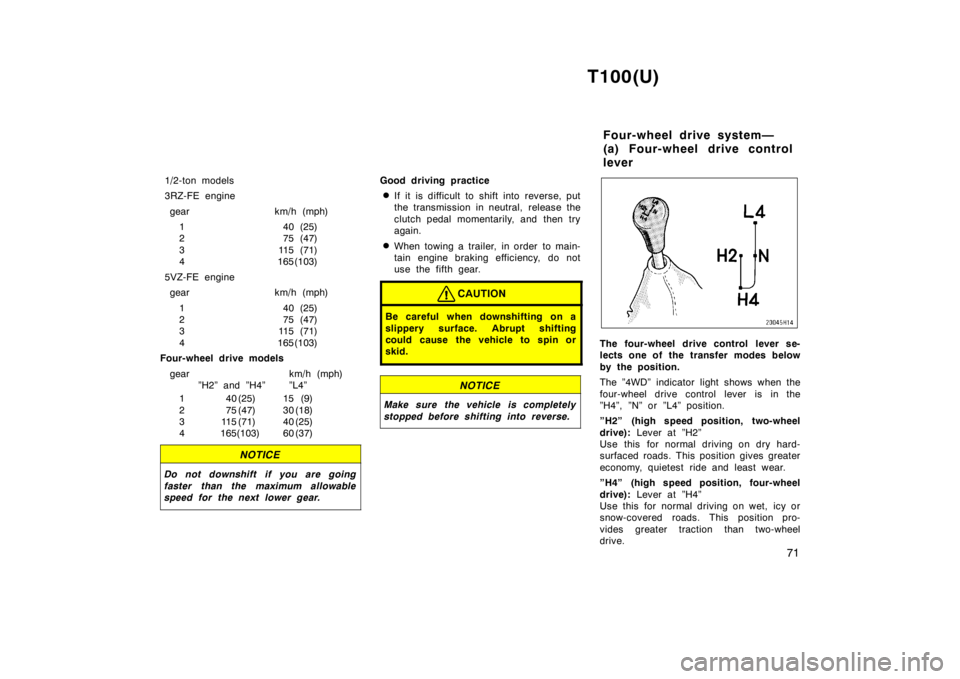
T100(U)71
1/2-ton models
3RZ-FE engine
gear km/h (mph) 1 40 (25)
2 75 (47)
3 115 (71)
4 165(103)
5VZ-FE engine gear km/h (mph)
1 40 (25)
2 75 (47)
3 115 (71)
4 165(103)
Four-wheel drive models
gear km/h (mph) ”H2” and ”H4” ”L4”
1 40 (25) 15 (9)
2 75 (47) 30 (18)
3 115 (71) 40 (25)
4 165(103) 60 (37)
NOTICE
Do not downshift if you are going
faster than the maximum allowable
speed for the next lower gear.
Good driving practice
� If it is difficult to shift into reverse, put
the transmission in neutral, release the
clutch pedal momentarily, and then try
again.
� When towing a trailer, in order to main-
tain engine braking efficiency, do not
use the fifth gear.
CAUTION
Be careful when downshifting on a
slippery surface. Abrupt shifting
could cause the vehicle to spin or
skid.
NOTICE
Make sure the vehicle is completely
stopped before shifting into reverse.
The four-wheel drive control lever se-
lects one of the transfer modes below
by the position.
The ”4WD” indicator light shows when the
four-wheel drive control lever is in the
”H4”, ”N” or ”L4” position.
”H2” (high speed position, two-wheel
drive): Lever at ”H2”
Use this for normal driving on dry hard-
surfaced roads. This position gives greater
economy, quietest ride and least wear.
”H4” (high speed position, four-wheel
drive): Lever at ”H4”
Use this for normal driving on wet, icy or
snow-covered roads. This position pro-
vides greater traction than two-wheel
drive. Four-wheel drive system—
(a) Four-wheel drive controllever
Page 124 of 214
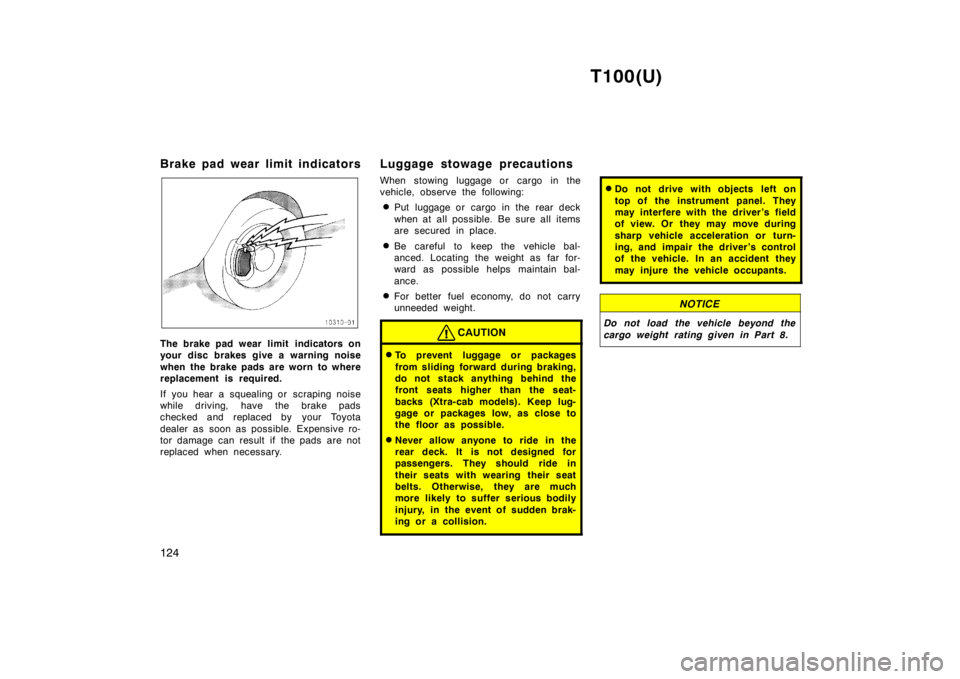
T100(U)
124
Brake pad wear limit indicators
The brake pad wear limit indicators on
your disc brakes give a warning noise
when the brake pads are worn to where
replacement is required.
If you hear a squealing or scraping noise
while driving, have the brake pads
checked and replaced by your Toyota
dealer as soon as possible. Expensive ro-
tor damage can result if the pads are not
replaced when necessary.
Luggage stowage pr
ecautions
When stowing luggage or cargo in the
vehicle, observe the following: � Put luggage or cargo in the rear deck
when at all possible. Be sure all items
are secured in place.
� Be careful to keep the vehicle bal-
anced. Locating the weight as far for-
ward as possible helps maintain bal-
ance.
� For better fuel economy, do not carry
unneeded weight.CAUTION
�To prevent luggage or packages
from sliding forward during braking,
do not stack anything behind the
front seats higher than the seat-
backs (Xtra-cab models). Keep lug-
gage or packages low, as close to
the floor as possible.
� Never allow anyone to ride in the
rear deck. It is not designed for
passengers. They should ride in
their seats with wearing their seat
belts. Otherwise, they are much
more likely to suffer serious bodily
injury, in the event of sudden brak-
ing or a collision.
�Do not drive with objects left on
top of the instrument panel. They
may interfere with the driver’s field
of view. Or they may move during
sharp vehicle acceleration or turn-
ing, and impair the driver’s control
of the vehicle. In an accident they
may injure the vehicle occupants.
NOTICE
Do not load the vehicle beyond the
cargo weight rating given in Part 8.